Jigs have been catching fish for so long it would seem there’s nothing new to learn about them. But not quite a decade ago, a variation came to the United States and revolutionized what we know about jig fishing. Call it Asian jigging, high-speed jigging, vertical jigging or butterfly jigging, after the trademark Butterfly jig by Shimano, which introduced this method to U.S. anglers; by any name it’s a deadly way to fish.
“I have not found a species I can’t catch with these jigs, except maybe flats fish,” says Capt. R. Andrew Cummings of Outer Cape Waterman, in South Wellfleet, Massachusetts, who has been fishing these jigs since they first appeared and continues to refine his techniques.
Speed jigging is just as effective on the West Coast. “If the fish are active, I will catch more on a jig than on bait – way more,” says Ben Secrest of Accurate Fishing Products, in Los Angeles, an early adopter and true believer in speed jigging.
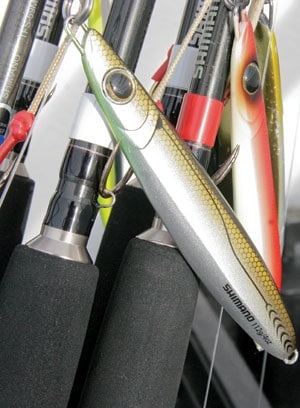
What is Vertical Jig Fishing?
A perfect storm of equipment allowed the development of this style of fishing: a combination of Japanese-designed lures, parabolic rods, compact reels with high retrieve rates and heavy drags, and no-stretch braided lines. Each of these elements makes an indispensable contribution to the system. Learn to make it work right, and the rewards are great, as many have already discovered.
In case this is a new fishing method to you, here’s how it works. A metal jig with free-swinging hooks is dropped beneath the boat and retrieved with a rhythmic motion that creates a vertical walk-the-dog action that’s irresistible to fish. The technique works over featureless bottom, plus it’s effective when fished through suspended schools of bait. It works over wrecks, reefs and rock piles. It works for rockfish, yellowtail and yellowfin tuna on the West Coast, stripers and bluefin tuna in the Northeast, and grouper, king mackerel, wahoo, snapper and tuna in the Southeast and the Gulf.
Vertical Jigging Setup and Rigs
The heart of the system consists of a short parabolic rod with a springy tip. Rods for this type of fishing are rated for the size of the jig that will be used. Mounted to the rod is a lightweight but beefy reel, either spinning or conventional. Because you hold the outfit and actively fish it, small reels light enough to be fished all day are essential. On the other hand, because the line and the quarry are anything but ultra-light, powerful, high-ratio gears and substantial drags are equally essential.
Reels get loaded with a minimum of 40-pound braid. Narrow spools are favored on conventional models. Speed jigging requires both hands, one on the side plate of the reel and the other on the reel handle, winding, so laying line on the reel is not an option. “Keep conventional reels narrow so you just wind and the line finds its own way home,” says Secrest.
Vertical Jigging Lures
The jigs themselves are where the rubber meets the road. Sizes range from 55 grams, just under 2 ounces, for shallow-water versions and up to nearly a pound and almost a foot long for deepwater species and big tuna. Jig action is determined by the cross section of the jig, as well as the action imparted by the rod, and every manufacturer has its own twist on cross section and shape. You’ll find subtle differences in the shapes by Shimano versus Williamson, which differ from those by Ocean Tackle International, among others.
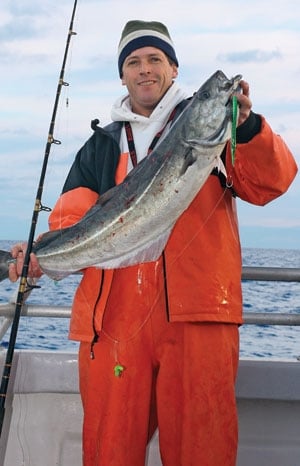
Once this specialized gear is assembled, it has to be activated. The speed-jigging system provides distinctive action to the jigs, and achieving that action is the angler’s job. It’s a tough technique to describe, and even those who teach it regularly admit it is a feel that must be acquired.
“The most important thing I teach anglers learning to fish these jigs is to think of the action of the jig as coming from the reel, not the rod,” Cummings explains. “Rather than resulting from your jigging the rod, the action is more a rhythm you create when you crank the reel.” Imagine cranking the reel hard, in a short burst so the rod tip dips under the load, he explains. Then when the rod straightens, make another fast, short spin of the reel handle to load the tip again and create a pulsating retrieve. When the action is right, the rod tip develops a lively feel of its own. “Everybody has their own cadence with the rod loading and unloading,” he says. “Learn to use the gear. It is what makes this type of jigging possible.”
Secrest notes a particular association between the type of speed jig and the preferred gear. “There are two types of jigs: a knife jig and a long jig,” he says. “The long jig is traditionally fished on a spinning reel, pulled vertically with a three-foot sweep, then released so it falls going right, left, right, left in a pattern that looks like a heart rate monitor, but vertical.” This is the traditional Japanese style of jigging. “In California, the only time we fish a long jig is with yellowtail,” he adds.
More than 80 percent of West Cost jigging is done with smaller knife jigs on conventional reels, says Secrest. “When you’re working the jig with conventional gear, the reel should travel in an eight-inch circle so the jig, instead of going up and down, is constantly moving,” he explains, describing the same retrieve that Cummings did, but in completely different words.
“The key is cadence,” says Secrest. “What happens is the angler establishes a rhythm, focuses on it and keeps it going.” Like any skill, it takes practice to learn the feel and repeat it. “The more you do it, the better you get,” he says.
Robby Gant, rod designer for Shimano, offers another entirely different set of instructions. “The technique is rod up, handle up, rod down, handle down,” he says. “It is a tight, compact motion, not giant sweeps, very much like working a Zara Spook, barely twitching the rod tip.” Beginners, he says, use their arm and get worn out quickly. Experienced jiggers use both hands to work the jig.
It is critical that the rod load and recover at the proper speed, which varies with the weight of the jig. “Beginners should look at the medium-heavy rods for starters,” he says. “Those that are built for 110- to 200-gram jigs work in most conditions.”
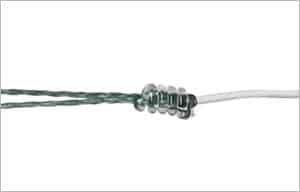
Get It All Together
Light line on a speed-jig outfit is 40-pound-test. More common is 65-pound-test, heavy enough to lie well on the spool and resist burying itself there, where it can bind and create problems ranging from lost fish to broken rods. Just in case it hasn’t sunk in, this is not light-line record fishing. Beefy is the word when it comes to tackle, lines, leaders and quarry.
Secrest often loads his reels by stacking line, which maintains reel capacity while providing the advantages of heavy line when fighting fish boat-side.
“I’ll put 200 yards of 65-pound braid on the reel, then add 200 yards of 80-pound and top it off with 100 to 200 feet of 100-pound-test,” he says. “I get the fish in to the 80-pound, get a couple of wraps on the reel, then add some heat to get the fish swimming in circles. Then when the 100-pound gets on the reel, I can put more pressure on the fish as it gets closer to the boat.”
Smooth connections are essential when rigging lines and leaders. Connections, especially when a long leader is used, need to be able to flow through the rod guides and wind smoothly onto the reel. The heart of this system is the loop-to-loop connections made with Bimini twists, whether for stacking the line or adding a fluorocarbon or nylon monofilament leader to the main line.
Bristol knots are used to fasten leaders to braid. Leaders are tied to welded rings with a clinch knot, and assist hooks are girth-hooked to the welded ring. Jigs are fastened to the welded ring with split rings to complete the rig.
Shimano has recently begun marketing PowerPro Hollow Ace, a hollow braided line that can be used to build wind-on leaders by sliding the leader into the center of the line so the braid tightens around the leader Chinese-handcuff style. “I am using a blind splice with the Hollow Ace,” says Cummings. “I feed about 4 feet of the leader into the braid, then serve it at each end with a nail knot or with whipping to hold it in place.” Hollow Ace can also be spliced into a loop with a splicing needle to allow loop-to-loop connections at any point.
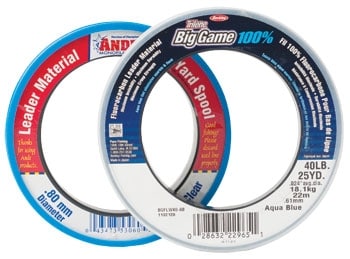
Best Leaders for Vertical Jigging
Leaders can be a contentious issue. Cummings is particular about using long leaders, whether they’re 40-pound fluoro for stripers or 80-pound for bluefins.
“I feel you need a much longer leader than most anglers routinely use,” he says. “I’ll start with a 25-foot wind-on leader and fish it until it gets down to 18 or 20 feet.
“I don’t know what happens, but there are times when we should get bit and we don’t. We change the leader, and boom, there it is. There is some relationship between the jig and the resistance of the leader.”
Secrest approaches things differently. “I seldom use more than 6 or 8 feet,” he says. “My leader is 60-pound nylon mono for rockfish, 80 for general use, and I’ll use 100- or 150-pound fluoro for tuna. I want to be able to put a couple of wraps around the reel spool with the fish at the boat. The length of the leader does not matter if I have the right rod for the size of jig I’m fishing.”
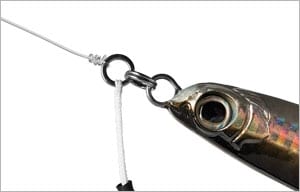
Hook Peculiarities
Unlike traditional jigs, which are built on hooks, speed jigs are fished separately from their hooks. The leader is tied to a welded ring, and jigs are fastened to that with a split ring. Assist hooks, rigged by hook manufacturers on Kevlar or cable leads, are girth-hooked to the same welded ring.
This configuration allows the jig to swing freely as it is worked through the water column, and when the strike takes place, the fish is hooked by a single hook or paired assist hooks, and the jig hangs free. It’s an action thing, says Cummings: “You want that jig independent so there is no drag or resistance on it.” Everything goes on the solid ring that is fastened to the leader. “Even the highest quality split rings will open,” he says. “I have landed a lot of tuna and not gotten the jig back.”
Cummings offers a couple of deviations in hook configuration. “Usually I use one assist hook instead of a pair,” he says. “I’ve found my hookup ratio is not compromised, and my landing rate seems better.” He also ties his own assist hooks, opting for a shorter lead than what is available in pre-rigged hooks. “I make them just long enough to loop to the welded ring, instead of letting them reach the bottom of the jig,” he says. “My hookup rate seems better, and it is a lot easier to handle the unhooking at boat-side with a shorter lead.”









